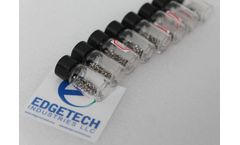Refine by
Biocompatibility Articles & Analysis: Older
96 articles found
These chemicals are used in coatings, adhesives, sterilization processes, and biocompatible materials that ensure safety and functionality. For example, hydrophilic coatings enhance the comfort and efficiency of catheters, while high-purity adhesives are indispensable in assembling intricate medical equipment. ...
As technology continues to advance, the possibilities for innovative medical tools like these marker bands are limitless. Safety and Biocompatibility of Platinum Iridium Markers Platinum Iridium markers are widely used in medical procedures to help guide doctors during treatment. Their durability and biocompatibility make them a popular choice for ...
Biomedical Applications: Some copolymers are biocompatible and can be used in drug delivery systems or tissue engineering. ...
This versatility, coupled with their biocompatibility and biodegradability, makes liposomes an attractive vehicle for drug delivery. ...
Known for their exceptional chemical resistance, biocompatibility, flexibility, and durability, fluoropolymers are enabling new and safer ways to perform complex medical interventions. ...
Tissue engineering: The protein's biocompatibility makes it a potential candidate for scaffolding materials in tissue regeneration. 3. ...
The unique properties of PEG derivatives, including their biocompatibility and ability to modify the solubility, stability, and bioavailability of drugs, make them indispensable in modern pharmacology. ...
Medical device biocompatibility testing is a quality control standard for the development and manufacturing of medical devices. ...
The designed dendrimers have strong stability and improved biocompatibility, and can be used through the design of multifunctional groups and binding sites. ...
For example, AI models can be trained to predict a material's mechanical strength, degradation rate, or biocompatibility based on its molecular structure and synthesis parameters. ...
Medical and Healthcare: The medical industry relies on silicone for a variety of applications, including medical devices, implants, and tubing. Its biocompatibility and resistance to bacteria make it suitable for sensitive medical environments. ...
PEG is soluble in organic solvents and water has excellent physicochemical and physiological properties, and is non-toxic, non-antigenic, and non-immunogenic. PEG is biocompatible and exhibits low protein and platelet adsorption in vivo as well as low cellular adherence, which are features that have led to a wide range of applications in biomedical fields. ...
Advantages of Copper-Free Click Chemistry l Biocompatibility: Copper-free click chemistry is inherently more biocompatible than traditional copper-catalyzed click reactions, making it suitable for use in biological systems and live cell imaging without causing cytotoxicity. l Selectivity: Copper-free click reactions offer high selectivity, allowing for specific ...
Colloidal gold is the most commonly used nanoparticle for optical labeling due to its ease of use, biocompatibility, and high visibility. It appears deep red in color, which can cause confusion in on-site testing as it displays the same color in two or more test lines. ...
Food and Drug Administration It is certified by the Food and Drug Administration (FDA) and is a copolymer material available on the market. PLGA has good biocompatibility, biodegradability, mechanical strength, good plasticity, surface modification, and drug encapsulation. ...
Collagen has been widely used in the clinical field due to its abundance in nature, biocompatibility, low antigenicity and biodegradability. In addition, the high tensile strength and fibril-forming ability of collagen enable it to be made into various forms such as tissue grafts, hydrogels, sponges, fibers, films, hollow spheres, and so on. ...
Polymer Nanoparticles for Drug Delivery Polymer nanoparticles are a popular choice for drug delivery systems due to their biocompatibility and versatility. These nanoparticles can be used to encapsulate drugs, protecting them from degradation and ensuring targeted delivery to specific sites in the body. ...
Recombinant human collagen, a natural biosynthetic material with good biocompatibility, low immunogenicity, degradability and absorbability, has been widely used in hemostasis, wound healing, drug slow-release carrier and tissue process. ...
One critical aspect of 3D printing is the materials used, which greatly impact the functionality and compatibility of the final product. What are Biocompatible Materials in 3D Printing? Biocompatible materials play a crucial role in various applications, particularly in the biomedical field. ...
It involves the layer-by-layer deposition of materials to create complex structures. Using biocompatible polymers or metals, microneedles can be printed with high precision and accuracy. ...













